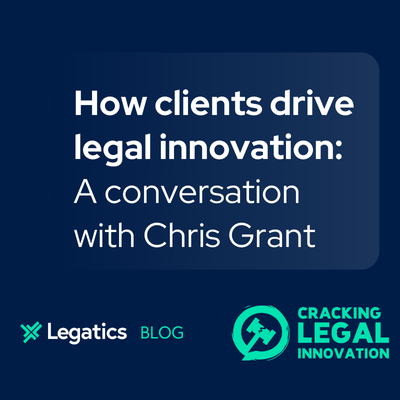A conversation with Chris Grant, Managing Director of Client Value, Goodwin, on our podcast Cracking Legal Innovation
Here’s a question that keeps innovation leaders awake at night: Why do law firms struggle to adopt technology when clients desperately want it?
The answer lies in a fundamental power dynamic that most clients don’t fully understand – or leverage. Chris Grant has spent two decades watching this dynamic play out from both sides of the table. As Managing Director of Client Value at Goodwin (formerly at HSBC and Barclays), Grant spearheaded major legal transformation programs, launched legal tech incubators, and helped redefine how legal services get delivered and priced.
In a recent conversation with Legatics CEO Anthony Seale and CCO Daniel Porus, Grant reveals why clients hold the key to innovation – and how smart firms capture value by truly understanding what clients want.
From pain giver to problem solver: The view from both sides
Grant’s transition from client-side to law firm offers a unique perspective on innovation dynamics. “I used to be what one of our firms likened to a dental appointment,” he laughs. “I was the pain giver. Now I’m getting the tooth extraction.”
The switch revealed surprising insights about law firm operations. “A lot of what I thought was going on behind the scenes was going on behind the scenes,” Grant explains. “But I’ve got a newfound empathy for law firms. I’m seeing why certain things were challenging, where we could make easier wins, and what was stopping us from doing things we wanted to.”
This inside view transforms how Grant approaches client value. Instead of fighting against law firm culture, he works with partners who proactively seek new approaches. “I’ve got partners coming to me with ideas about how to price in different ways. It’s not as if I’m dragging these things from the firm. They’re very proactively seeking ways of doing things differently.”
The client power dynamic: Why lawyers jump when you ask
Clients possess tremendous power to drive change – if they understand how to use it. Grant advocates for a more demanding approach, but with a strategic purpose.
“If there’s one thing that makes lawyers jump however high they are asked – it’s a client request,” Porus observes.
Grant agrees but adds nuance and warns against misusing that leverage. The relationship between clients and law firms creates opportunities for both constructive collaboration and problematic exploitation.
“You are the client. You can ask for certain things, right? There is that position, not necessarily a power. I don’t want to be in that situation where sometimes it can be abused,” Grant explains, pointing to practices like demanding free secondments.
Grant sees both sides of this dynamic. While free secondments can help firms build relationships and embed themselves with clients, they also represent a troubling precedent where “client demands, client gets” becomes the default approach.
The key lies in redirecting that influence toward innovation rather than extracting free resources. “I think we could use that power in other ways. I don’t think everybody maximizes it,” Grant notes.
The collaboration strategy
Smart clients amplify their influence through coordination. Grant drove significant banking sector change by bringing institutions together around shared demands. “I’ve driven a lot of change on the banking side by bringing banks together to make a bigger demand of the law firms they’re working with,” he explains. “There’s five of you all demanding this. Let’s see what we can do to make this happen.”
This collective approach transforms the conversation from “how high do I need to jump?” to “we can fly if you want.”
Outputs over inputs: The value framework that actually works
Grant champions a fundamental shift in how clients evaluate legal services: focus on outcomes, not activities.
“We don’t really care how you do the work, so long as the work is done,” he states bluntly. “Doesn’t matter if it was two hours, 20 hours, 90 hours – but did that work actually get us to the right result?”
The real questions clients should ask:
- Was the deal done faster?
- Was it done smarter?
- Was it done cheaper?
- Did you think more effectively about execution?
This output-focused approach eliminates endless debates about billable hours. “We spend so much time talking about hours at the beginning, then we talk about them again at the end,” Grant notes. “What are the outcomes we want to achieve? Let’s look at it from that perspective.”
Effective fee arrangements: Beyond the billable hour theater
Grant distinguishes between “alternative fee arrangements” and “effective fee arrangements” – a crucial difference that most firms miss.
The distinction centers on accountability to hourly billing. Alternative fee arrangements often maintain underlying hourly tracking – firms still calculate time spent and reference billable hours when problems arise or scope changes. Effective fee arrangements eliminate this fallback entirely. Success gets measured purely by outcomes delivered, timeline met, and value created, with no reversion to “we spent X hours, so we deserve Y payment.”
This fundamental shift forces both sides to focus on results rather than activity, creating genuine alignment between client objectives and firm incentives.
At HSBC, Grant achieved an 80% effective fee arrangement target by demanding transparency from law firms. “I want you to do the analysis on your matters, and I want you to come back and tell us how well they’re working from your perspective,” he told firms.
The results surprised everyone. Firms admitted shortcomings but committed to improvement: “We’re not quite at 80%, but we started at 40%. We’re now at 60% because I’ve gone back and made sure those matters have changed.”
The trust factor
This honest dialogue built mutual understanding. Firms identified scoping challenges while clients recognized their role in successful implementations. Some firms even requested rate card elimination: “Take out the rates. We don’t need a rate card. We’re very comfortable working with you on effective fee arrangements.”
Innovation theater vs. real deployment: The technology gap
Grant identifies a persistent problem: firms promise technology in pitches but fail to deliver during matters.
“There definitely was innovation theater,” Grant acknowledges. “Firms throw everything including the kitchen sink at RFPs, hoping something sticks.”
But clients share responsibility for this dynamic. Regulatory constraints and internal approval processes prevent clients from actually leveraging the technology they request. “We’re asking questions that we’ve already set up to fail, because regardless of the answer, we can’t use it,” Grant explains.
The path forward
Grant sees progress emerging as firms mature in their technology deployments. The key lies in accountability: “Did you deploy it on our matter? How are you going to deploy it on our matter? Making sure that it then happens and is delivered.”
The cost conversation: Who pays for innovation?
The question of technology costs creates ongoing debate between clients and firms. Grant advocates for transparency and value-based pricing.
“If there’s something that’s going to be a clear benefit to me, where we’ve got options – traditional way of throwing 30 lawyers at it, or we could bring in this technology – that’s maybe something we have the conversation around,” Grant explains.
The investment lifecycle
Grant compares technology investment to infrastructure development: significant upfront costs that decrease over time as adoption scales. “There will always be this front-loaded, significant investment to bring something on board, but that then starts to taper off over time.”
The key principle: no hidden charges. “Nobody likes a hidden charge. If we’re going to change where the pricing goes, we need to be very clear about what makes up our costs.”
Data-driven relationships: The future of legal services
Grant envisions a transformed relationship where law firms use data insights to provide predictive value.
“What I really wanted was a law firm to come to me and go, ‘Something’s brewing. There are flags pinging on our data that we think is going to drive a challenge for you in the next six months. We’re here for you, and here’s what we’re going to do to help negate that.'”
This predictive approach flips the industry from reactive problem-solving to proactive protection. Law firms become true strategic partners rather than just service providers.
The business transformation imperative
The conversation reveals a fundamental truth: law firms must learn to operate like businesses, not just legal service providers.
Porus notes how firms often lack operational data that other industries take for granted: “Who’s on certain transactions, client relationships, how big were transactions, how does cost depend on parties involved. These would be basic operational questions with data-backed answers for any other business.”
Grant agrees: “It’s probably the only way forward. What you need to do is bring in people that know how to run a business. Other industries do things in different ways. They do things in better ways.”
The innovation partnership model
Grant’s vision extends beyond traditional client-firm relationships toward embedded partnerships that drive industry transformation.
“Let’s have more early, honest conversations. Create space outside of matters to talk about ideation and shared pilots,” he advocates. “We have to create the space for that.”
This collaborative approach requires moving beyond hourly billing toward outcome-based relationships that reward innovation and efficiency.
Key takeaways for innovation leaders
For clients:
- Use your influence strategically to demand genuine innovation
- Coordinate with other clients to amplify change requests
- Focus evaluation on outcomes, not activities
- Create space for honest feedback conversations
- Invest in technology approval processes that enable innovation
For law firms:
- Treat client value as a business discipline, not a marketing exercise
- Develop genuine expertise in outcome-based pricing
- Use technology deployments to differentiate, don’t just promise them
- Build data capabilities that enable predictive insights
- Embrace business operations principles alongside legal excellence
The future of client-firm partnerships
Grant’s experience demonstrates that meaningful innovation requires partnership between clients and firms. Neither side can drive transformation alone.
“Law firms will run more like businesses. We will have deeper relationships with our clients that allow us to deliver against their expectations and work focused on outcome and value,” Grant predicts. “We will have much greater data insight that will help steer us in a different direction.”
The firms that master this transition – guided by professionals who understand both client needs and law firm operations – will define the future of legal services.
This conversation is from the Cracking Legal Innovation podcast. Listen to the full episode for more insights on client value, innovation strategy, and the transformation of legal services. Subscribe to Cracking Legal Innovation on Apple Podcasts, Spotify, or wherever you get your podcasts.
Ready to see how technology can drive genuine client value? Request a demo of Legatics today.






